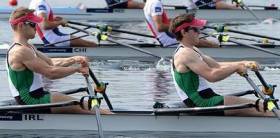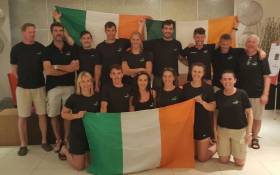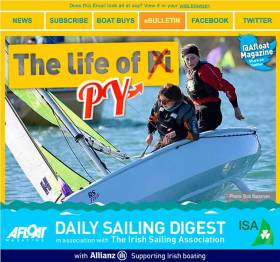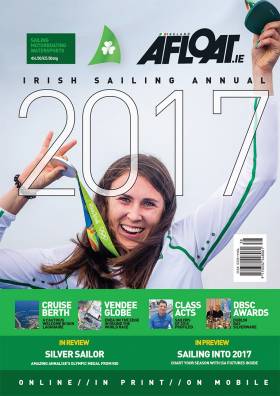Displaying items by tag: Afloat
O'Donovans Head for Lucerne as Afloat Rowers of Month
#Rowers of the Month: Paul O’Donovan and Gary O’Donovan are the Afloat rowers of the month for June. Both brothers showed outstanding form at Cork Regatta. Paul O’Donovan won the single sculls. In the heats, Gary had not been the next fastest, but come the final the elder O’Donovan brother was second only to Paul. The two raced in the double, where they were tested by Fintan and Jake McCarthy, but came through with the win.
The O’Donovans were run close by David O’Malley and Shane Mulvaney. The UCD pair were outstanding at Cork Regatta. They won the pairs title, beating world lightweight champions Shane O’Driscoll and Mark O’Donovan, and they slotted into the UCD four which also won. O’Malley and Mulvaney form the Ireland lightweight pair in a strong team for the World Under-23 Championships this month. The O’Donovans, who went on to reach the final at Henley Royal Regatta, head for the World Cup in Lucerne next weekend (July 13th to 15th). Good luck to all those competing in this busy month.
Rower of the Month awards: The judging panel is made up of Liam Gorman, rowing correspondent of The Irish Times and David O'Brien, Editor of Afloat magazine. Monthly awards for achievements during the year will appear on afloat.ie. Keep a monthly eye on progress and watch our 2018 champions list grow.
Award Follows Paul O'Donovan's Premier Achievement
#Rower of the Month: The Afloat Rower of the Month for February is Paul O’Donovan. The Skibbereen quartet of Mark O’Donovan, Shane O’Driscoll, Paul O’Donovan and Gary O’Donovan warmed slowly to their task in competing in the New Zealand Rowing Championships. The arrival of coach Dominic Casey helped. When finals came around, they won a bronze medal as a four. But topping this achievement was that of Paul O’Donovan in the Premier Single Sculls. The lightweight world champion mixed it with two of the top heavyweights in the world: O’Donovan finished third, just a few boat lengths behind Robbie Manson, who in 2017 set the world’s fastest time, and ahead of Olympic champion Mahe Drysdale.
The achievement makes Paul O’Donovan the Afloat Rower of the Month.
Rower of the Month awards: The judging panel is made up of Liam Gorman, rowing correspondent of The Irish Times and David O'Brien, Editor of Afloat magazine. Monthly awards for achievements during the year will appear on afloat.ie. Keep a monthly eye on progress and watch our 2018 champions list grow.
https://www.facebook.com/WorldRowing/videos/10160199271930651/
O'Driscoll and O'Donovan are Afloat Rowers of the Year
#Rowers of the Year: The Afloat Rowers of the Year for 2017 are Shane O’Driscoll and Mark O’Donovan. The two formed the Ireland lightweight pair which won European and World Championship gold. They also won gold in each of the three World Cup regattas, in Belgrade, Poznan and Lucerne. Their glorious run was the pay-off for enormous amounts of work – and a drive which came from their determination to make their mark after coming up short the in 2016, when they finished fourth at the World Championships.
The two have opted to move up to heavyweight with the aim of competing at the Olympic Games in Tokyo in 2020. Afloat wishes them every success.
Afloat Rower of the Month awards: The judging panel is made up of Liam Gorman, rowing correspondent of The Irish Times, and David O'Brien, editor of Afloat magazine. Monthly awards for achievements during the year appeared on afloat.ie.
Ireland Team the Afloat Rowers of the Month for September
#Rowing: The Ireland team which brought the country glory at the World Rowing Championships in Florida are the Afloat Rowers of the Month for September. In that month, Ireland took two gold medals through Mark O’Donovan and Shane O’Driscoll in the lightweight pair and Paul O’Donovan in the lightweight single sculls.
The pair crowned the perfect season with their victory. They won gold at the three World Cup regattas and the European Championships. The pressure was on in World Championship final, with both Brazil and Italy rowing well on the day. But O’Donovan and O’Driscoll were peerless. They set a very high stroke rate, took the lead – and saw off their challengers.
Paul O’Donovan retained the title he had taken with such an extraordinary set of performances in Rotterdam in 2016, just weeks after he had taken a silver at the Olympic Games in a lightweight double with his brother Gary. This time, Gary had to drop out of the lightweight double, as illness had restricted his training (he supported the team as a reserve). Paul was back in the lightweight single in a boat which was new to him. He won all four races (heat, quarter-final, semi-final and final), seeing off a new set of challengers in the lightweight single, including Matthew Dunham of New Zealand, who took silver, and Kris Brun of Norway (bronze).
The rest of the Ireland team also gave the suppporters plenty to shout about. Sanita Puspure went on to take fourth in the single sculls and Denise Walsh reached the A Final of the lightweight single sculls, where she finished sixth. Two new heavyweight pairs gained experience of the top level as the team targets Tokyo 2020. Aileen Crowley and Aifric Keogh finished eighth and there was a 16th place for Patrick Boomer and Fionnán McQuillan-Tolan.
Well done to all the members of the Ireland team, the Afloat Rowers of the Month for September.
Rower of the Month awards: The judging panel is made up of Liam Gorman, rowing correspondent of The Irish Times, and David O'Brien, editor of Afloat magazine. Monthly awards for achievements during the year will appear on afloat.ie. Keep a monthly eye on progress and watch our 2017 champions list grow.
Commercial Eight the Afloat Rowers of the Month
#Rowing: July 2017 was one of the most successful months for Irish rowing. There were multiple medals at international regattas: the World Cup in Lucerne, gold and bronze; the Under-23 World Championships, two bronze medals; Coupe de la Jeunesse, five gold medals; six wins at the Home International Regatta; a good showing by the Clonmel junior quadruple at Henley Royal Regatta.
The Irish Rowing Championships regatta was the biggest ever. NUIG took nine titles. Enniskillen won the junior women’s and men’s eights (and fours) and the junior 16 women’s and men’s eights. Three Castles, with two wins, and UCC with a breakthrough win at novice level, had reasons to celebrate. Cork Boat Club and Bann could boast the champion junior single scullers as part of their three wins.
Skibbereen’s top-rank rowers, usually ruled out by the international programme which sees them bring glory to their country, came to the show and helped the club to seven titles. Two Olympians, Sanita Puspure and Claire Lambe, took titles for Old Collegians and also helped UCD/Old Collegians to take the women’s senior eights crown. UCD had also won the women’s senior pair and the men’s intermediate eight.
Year after year, the men’s senior eights final is the highlight of the Championships. This time out the Skibbereen eight could call on some of the best lightweight rowers in the world. The race was magnificient. In the closing stages, NUIG looked like they might revive the days of their domination; Skibbereen charged to the line. Commercial won. A crew of club rowers had put everything on the line and gained their reward.
They are the Afloat Rowers of the Month.
Rower of the Month awards: The judging panel is made up of Liam Gorman, rowing correspondent of The Irish Times, and David O'Brien, editor of Afloat magazine. Monthly awards for achievements during the year will appear on afloat.ie. Keep a monthly eye on progress and watch our 2017 champions list grow.
Sign up for Today's Irish Sailing & Boating News
Johnny Durcan tops fleet of 50 to cash in at Royal Cork’s PY1000, 1720s take Spring Chicken 1-2, girl power triumphs at Leinster Schools champs, and four Irish 49ers launch Olympic bid in
Roy takes over the helm of Irish Sailing
Former Olympic race officer Jack Roy is voted in as new ISA President, ISORA will trial ECHO for a ‘better spread of prizes’, & Winkie Nixon calls on VDLR to seize chance for in-harbour drama.
Progress in Rescue 116 recovery op
Marine Institute’s Holland 1 ROV plays key role in recovery of Rescue 116 pilot Mark Duffy and black box, Norway plans world first ship tunnel, & Greenway to Waterford Copper Coast opens.
New Irish rowing chief vows shake-up
Rowing Ireland critic Eamonn Colclough lands top job at dramatic agm, Gary O’Donovan hits mark atIrish trials after heats scare from clubmate, and Irish crews are left high and dry in London.
Get your daily Irish Sailing and boating digest delivered to your inbox (FREE). Sign up HERE.
Buy Your 2017 Afloat Annual Below – €6.50 plus P&P
Show Your Support For Afloat.ie
If you value Afloat's coverage of sailing, boating and maritime affairs please help to fund it.
Afloat's combination of opinion, hard news and features puts it at the very heart of the national conversation on sailing, boating and maritime affairs.
At a time when many ports around our coasts are in the process of change, the needs of marine communities are being overlooked but it is essential this voice is heard.
Producing in-depth, well-reported journalism is difficult and expensive. Supporting us isn't.
Afloat.ie – like the rest of the media – is operating in an incredibly challenging commercial environment.
Afloat's popular online format has a strong returning readership with around 48% of daily visits being return visitors. In fact over the peak maritime months in 2016 Afloat surpassed its own record with an average of 90,000 unique visitors who availed of our free internet service.
Now we're asking our readers to help us. If everyone chipped in, we can enhance our coverage and our future would be more secure. You can help us through a small donation below.
If you have already done so, thank you. It means a lot to us.
1. Donate by Online Bank Transfer or Cheque
This is the most cost-effective way to donate to Afloat, as we receive 100% of your donation. For an online transfer, please call us on 01 284616 for our Bank details.
If you wish to donate by cheque send it to:
Baily Publications Ltd,
PO Box 12561,
Dun Laoghaire,
Co. Dublin.
Please make your cheque payable to Baily Publications Ltd (and write on the back 'Afloat)'.
2. Donate by PayPal or Credit Card
Click the button below to pay directly into our PayPal account using your own PayPal account or by choosing the 'pay with credit card option' if you don't have a PayPal account.
Read Today's Irish Sailing & Boating E–News from Afloat.ie
Read our e–news below and sign up for a daily digest of Irish sailing and boating news direct to your email on our home page.
AfloatDaily_Sept28
|
Ireland Oarsmen the Afloat Rowers of the Month
#Rowing: The Rowers of the Month for July are Mark O’Donovan and Shane O’Driscoll of Skibbereen. The Irish Championships offered a list of great performances: the Commerical senior eight won a thrilling final; the Cork Boat Club junior pair of Amy Mason and Tara Hanlon impressed and would go on the take silver at the Coupe de la Jeunesse; the rising star that is Daire Lynch took three titles. However, O’Donovan and O’Driscoll had the outstanding run, taking five titles: together they won the senior pair and senior double, while O’Donovan won the senior single sculls and O’Driscoll the lightweight single. They also teamed up with Fintan McCarthy and Kenny McCarthy to win the senior quadruple. The combined efforts of all the Skibbereen crews brought them 13 titles, lifting the west Cork club to 163 in total, clear at the top of the rankings as the most successful Irish club.
Mark O’Donovan and Shane O’Driscoll will represent Ireland in the lightweight pair at the World Championships in Rotterdam in late August.
Rower of the Month awards: The judging panel is made up of Liam Gorman, rowing correspondent of The Irish Times, and David O'Brien, editor of Afloat magazine. Monthly awards for achievements during the year will appear on afloat.ie and the overall national award will be presented to the person or crew who, in the judges' opinion, achieved the most notable results in, or made the most significant contribution to rowing during 2016. Keep a monthly eye on progress and watch our 2016 champions list grow.
























































































